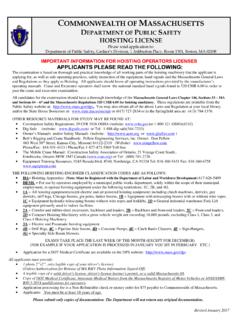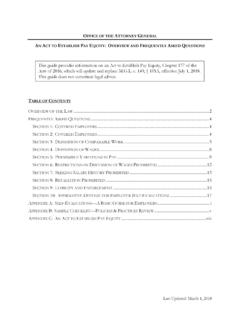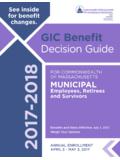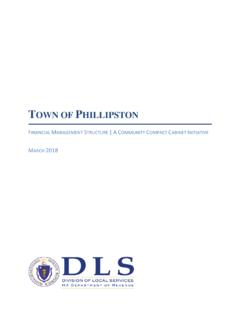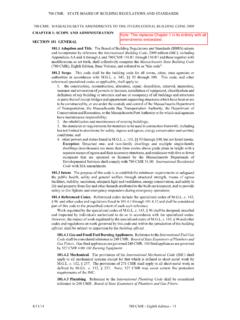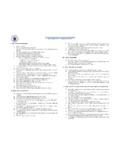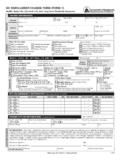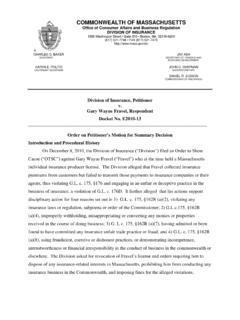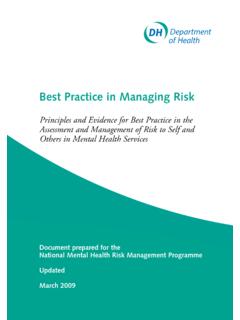Transcription of Asset Management: A Best Practice Introduction
1 1 Asset Management: A best Practice Introduction Purpose This guide will help you understand: The definition of Asset Management . Why Asset management is important to your utility. The best practices in Asset management. Target Audience This guidance is intended for owners, managers, and operators of water, sewer, and stormwater systems, local officials, technical assistance providers and state personnel. The primary focus of this guidance is for Massachusetts water, sewer and stormwater systems, but this guidance may be applied to any utility. Asset Management Asset management is defined as achieving a desired level of service from your assets through maintenance at the lowest life cycle cost.
2 Lowest life cycle cost refers to the best appropriate cost for rehabilitating, repairing or replacing an Asset . Asset management includes three major categories of physical assets: land and buildings, equipment and consumable supplies and materials. Reliable utility service can be provided through an Asset management program and typically includes a written Asset management plan. Challenges faced by Utilities Benefits of Asset Management Determining the best (or optimal) time to rehabilitate/repair/replace aging assets. Increasing demand for services. Overcoming resistance to rate increases. Lack of Asset investment, deferred maintenance and insufficient resources.
3 Rising service expectations of customers. Increasingly stringent regulatory requirements. Responding to emergencies as a result of Asset failures. Aging Asset infrastructure. Need to build more resilient infrastructure that can mitigate potentially devastating effects of severe storms Protecting assets. Prolonging Asset life and aiding in rehabilitate/repair/replacement decisions through efficient and focused operations and maintenance. Meeting consumer demands with a focus on system sustainability. Setting rates based on sound operational and financial planning. Budgeting focused on activities critical to sustained performance.
4 Accounting focused on providing operating and maintenance costs by Asset . Meeting service expectations and regulatory requirements. Improving response to emergencies. Improving security and safety of assets. Implementing Asset Management: The Core Framework A good starting point for any size water system is the five core questions framework for Asset management. This framework walks you through all of the major activities associated with Asset management and can be implemented at the level of sophistication reasonable for a given system. These five core framework questions provide the foundation for many Asset management best practices .
5 Several Asset management best practices are listed for each core question on the following pages. 2 Flow Chart: The Five Core Elements of Asset Management Asset Management 3. Critical Assets 2. Service Levels 1. Current State of Assets4. Minimum Life Cycle Costs 5. Long-Term Funding Plan 3 1. What is the current state of the system s assets? The first step in managing assets is knowing their current state. The accounting officer should have an inventory of fixed assets which generally consists of land, buildings, improvements to buildings, machinery and equipment, vehicles, pipes, pump stations, wells, appurtenances, and/or infrastructure consistent with a capitalization policy.
6 A capitalization policy is used to set a threshold, above which qualifying expenditures are recorded as fixed assets, and below which assets are charged as expenditures. There should be a capitalization policies for fixed assets and for infrastructure1. The fixed assets inventory should identify the Asset description, the Asset location, the original cost, the useful life, the accumulated depreciation and the net book value. The net book value is the original cost less accumulated depreciation. The fixed assets inventory may or may not contain the Asset condition and typically does not include replacement costs. The fixed assets accounting system may include capital budgeting, depreciation, impairment, and disposal and includes other areas of interest to the accounting officer, including the record keeping, operating and maintenance line item accounting, controls, policies and procedures, measurements, Asset tracking, and auditing procedures related to fixed assets.
7 Over time, as assets are rehabilitated, repaired or replaced, the inventory will be updated. An Asset management plan is not a static report but a live inventory best housed in a database that is updated when new information is available. You should ask: What do I own? Where is it? What is its condition? What is its useful life? What is its value? best practices include: Reviewing the Asset inventory with the accounting officer. Preparing an Asset inventory and system map. Adjusting the Asset inventory with the accounting officer. Developing a condition assessment and rating system for each Asset . Assessing remaining useful life by consulting projected-useful-life tables or decay curves.
8 Determining Asset values and repair/rehabilitating/replacement costs. 1 See recommended policies in Appendix 1, Table 1 of the Department of Revenue s GASB 34 Implementation Guide, 4 2. What is my required sustainable service level for assets? Knowing the required sustainable level of service will help implement an Asset management program and communicate to stakeholders what is being done. Quality, quantity, reliability, and environmental standards are elements that can define level of service and associated system performance goals, both short- and long-term. Information about customer demand, data from utility commissions or boards, and information from other stakeholders should be used to develop the level of service requirements.
9 Level of service requirements can be updated to account for changes due to growth, regulatory requirements, and technology improvements. You should ask: What level of service do stakeholders and customers demand? What do the regulators require? What is the actual performance? What are the physical capabilities of assets? Which assets are critical to support current and planned programs? Does the organization have sufficient resources (people and systems) to plan and manage assets? best practices include: Understanding the current service level of each Asset . Analyzing current and anticipated customer demand and satisfaction with the system.
10 Understanding current and anticipated regulatory requirements. Deciding how critical each Asset is and rank them accordingly. Writing and communicating to the public a level of service agreement that describes the system s performance targets. Using level of service standards to track system performance over time. 5 3. Which assets are critical to sustained performance? Because assets fail, how the consequences of failure are managed is vital. Not every Asset presents the same failure risk, or is equally critical to the system s operations. Therefore, it is important to know which assets are required to sustain the system s performance.
